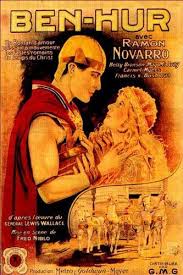
In Bethlehem a child is born who many believe was prophesized as a King to deliver the Jews from oppression. Years go by as the child grows. While the people waited for their savior the new Governor , Gratus, arrives in Jerusalem. Along with him are throngs of Roman soldiers. One of them is Messala (Francis X. Bushman). Messala is reunited with his childhood friend Judah Ben-Hur (Ramon Novarro). What at one time was unimportant for children is now a prejudice that infects all of Rome.
Messala is now a cold corrupt officer. When a tile from the roof of the Ben-Hur home narrowly hits Gratus as he marches through the streets Messala is quick to accuse Judah of trying to kill the governor. He has Judah sent to the galleys and his mother, the Princess of Hur (Claire McDowell), and sister Tirzah (Kathleen Key) are thrown in prison.
Judah toils for three years as a galley slave on a Roman war ship when Admiral Quintus Arrius (Frank Currier) takes over running the ship. Judah’s strength and determination impresses Arrius. When the ship is attacked by pirates he has Judah unchained. The ship is rammed and pirates flood onboard. During the battle Judah saves Arrius’ life. Arrius ends up being a hero and he makes Judah his adopted son. Judah is trained in the sport of chariot racing and becomes a champion.
Believing his mother and sister are dead Judah eventually returns to Jerusalem to avenge their death in the chariot arena racing against Messala. The wager is all of Messala’s riches.
“Ben-Hur: A Tale of Christ” was released in 1925 and was directed by Fred Niblo and B. Reeves Easton. It is an epic silent film and one of the many film adaptations of the story. It is based on the 1880 novel by General Lew Wallace. In 1997 it was selected for preservation in the United States National Film Registry by the Library of Congress as being "culturally, historically, or aesthetically significant." The film is the first feature-length adaptation of the novel and second overall, following the 1907 short.
The 1925 version of the film includes more of the religious aspects of the story than the 1959 version. When comparing the two films, and everybody does, there are a couple things that make this film either on par or even more impressive than the 1959 version with Charlton Heston. The chariot race of course and the sea battle.
The battle at sea between the pirates and the Romans was amazing and is probably one of the best naval battles ever. You’ll probably have to watch that part more than once to see everything on screen. Pirates be nasty. Forty-eight cameras were used to film it, supposedly a record for a single scene. Since unemployment was rampant at the time, many of the extras lied when asked if they could swim. A staged fire on one of the ships got out of hand and sent armor clad extras jumping into the sea. Rumors abound as to if anyone drowned and, if so, that they were weighed down so no one would find out.
Although not as impressive as the sea battle, the chariot race has its own rumors. The race that was filmed in Italy was scraped and reshot in California. Supposedly one stuntman died in Italy and many horses in California. Forty-two cameras and 200,000 feet of film were used to catch all the action. Changes in laws concerning animal actors were enacted because of the movie.
The cast was rumored to be over 125,000 people. Among the thousands of extras were many “A” list actors. The production used more than 600 gallons of Max Factor's Liquid Body Make-up. There is a little nudity in the film but since it is considered a religious picture censors allowed it. At almost four million dollars it was the most expensive film in the silent film era. Especially considering this was 1925.
One unusual special effect that was impressive in the film was when Jesus waves his hand over Judah’s mother and sister curing them of leprosy. The trick was done by cinematographer Karl Struss. Make-up was applied to the faces of the two women making them look ill. Under a certain colored filter the makeup is no longer visible making the women look cured. As the hand is waving over the women the colored filter is changed. The women go from lepers to cured. This technique was also used in the transformation from Jekyll to Hyde in the film “Dr. Jekyll and Mr. Hyde” 1931 only then the technique was done in reverse. The trick is only possible for black and white film.
It’s one silent film that everyone should see. Even if all you watch is the sea battle.

